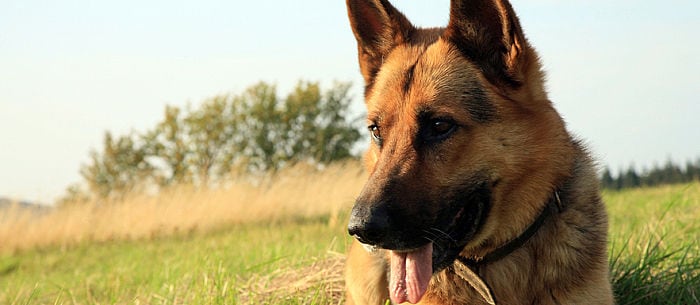Your poor pup just got himself a hip dysplasia diagnosis. What now?
First of all, what does this mean? Canine hip dysplasia is a developmental malformation typically seen in large breed dogs, such as German shepherds. It occurs when the ball and socket portions of the hip joint don’t meet together properly. Thus, instead of gliding smoothly, the hip joint grinds and grates, causing pain and mobility issues for your dog.
When to Visit Your Veterinarian
Because hip dysplasia in dogs is an inherited condition, selective breeding is the only real prevention method. According to Dr. Karen Becker, a veterinarian and integrative pet care expert at Mercola Healthy Pets, early identification is crucial. If you have an at-risk dog, she recommends X-rays to get an idea of what the hips look like before you ever notice symptoms.
“If you’ve never had your German shepherd X-rayed and he starts limping or slowing down on your walks, get him to the vet immediately. The sooner you can get that diagnosis, the sooner you can begin easing some of the effects,” she says.
While there is no cure for hip dysplasia, if your dog has already received a diagnosis, there are things you can do to alleviate the impact. Dr. Carrie Fleming Schuler, a veterinarian and co-owner of Northwest Neighborhood Veterinary Hospital in Portland, Oregon says, “Once a dog has been identified with hip dysplasia, prevention and slowing of arthritis becomes the goal.” Dr. Becker agrees, “We want to do everything we can to decrease the likelihood of hip dysplasia creating quality of life issues for your dog.”
Here are some tips for dealing with hip dysplasia in dogs:
- Decrease Intensity
Dr. Schuler recommends providing low impact exercise daily, such as slow leash walks or swimming.
- Keep the Pounds Down
Maintain your dog’s weight. Extra weight equals extra strain on the joints.
- Get Cozy
Keep your dog warm during colder weather (with a sweater or coat and extra bedding, for example) to reduce arthritic pain in winter months.
- Make the Perfect Home Life
Provide a soft sleeping area, such as an orthopedic foam bed. Lay rugs down on slippery floors to help your dog avoid slips and falls.
- Avoid the Stairs
Utilize ramps to help your dog avoid climbing stairs whenever possible.
- Think Outside the Vet’s Office
Your dog’s mobility might benefit from physical therapy, including stretching and hydrotherapy. Some holistic approaches, like acupuncture and acupressure, may make pain management and mobility easier.
- Find the Best Remedy
Dr. Becker recommends giving cartilage-protecting supplements such as glucosamine and chondroitin sulfate. Control pain when needed with nonsteroidal anti-inflammatories and narcotics prescribed by your veterinarian.
- Perfect the Diet
Feed a healthy diet rich in quality proteins, essential fatty acids and antioxidants such as vitamins C and E.
- Work Those Muscles
Focus on muscle-building exercises that work the rear limb muscles, like sit-to-stands and walking uphill.
- Get the Magic Touch
Massaging the muscles around the hip area can help relieve some aches and pains.
- Check for Extreme Options
In severe cases of hip dysplasia, especially in young dogs, surgery may be an option — albeit an expensive one. Consult with a vet before deciding if it’s right for your dog.
What Your Dog Walker Needs to Know
When entrusting your dysplastic dog to the care of a dog walker or pet sitter, you want the caregiver to understand the condition and the physical limitations it places on your pet. “Owners should give their dog walker or pet sitter very clear instructions, not only on medications (both prescriptions and supplements) but on the number and duration of walks,” says Dr. Schuler. Be sure to let your dog walker know what kind of play your dog can handle, too.
“Bottom line,” says Dr. Becker, “the whole name of the game is to make your dog feel fantastic for the whole time it’s in its body.”
Andrea Dashiell is a freelance writer whose work has been published in The Seattle Times, Seattle Magazine, ParentMap, Parents.com, Daily Candy and Red Tricycle.



